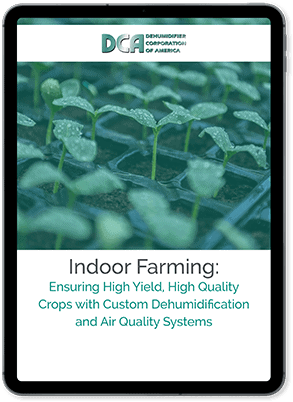In recent years, more and more farmers have realized the benefits of growing crops in different types of controlled environments. This increased awareness has led to a significant rise in the popularity of indoor grow rooms—i.e., enclosed spaces that allow users to achieve and maintain precise environmental conditions to increase crop yield and quality, essentially being able to provide “Mother Nature’s Best Day” every day. One of the key controlled parameters in grow rooms is humidity which, at the proper levels, can significantly improve crop quality and shorten grow cycles.

Below, we discuss why controlling grow room humidity is important, how temperature affects humidity levels, and how to choose the right dehumidifier for a given grow application.
Why Is Grow Room Humidity Control Important?
When operating grow rooms, it’s essential to avoid humidity extremes. Since humidity affects how much water and nutrients plants take in, both too little humidity and too much humidity can cause problems with crop growing operations. Too little humidity can lead to slow crop growth, poor leaf development, and a high risk of dehydration and heat stress, while too much humidity can lead to mold and bud rot, poor nutrient uptake, and mildew development.
How Does Temperature Affect Humidity Levels?
Indoor grow room temperature has a direct correlation to room relative humidity. Room air temperature directly affects how much water vapor room air can hold. Lower temperatures result in lower water vapor retention, and higher temperatures result in higher water vapor retention. As such, given a constant amount of water vapor in the air, the relative humidity will increase as temperatures fall and decrease as temperatures rise.
Generally, common HVAC systems are designed to transfer heat primarily while providing some moisture removal. Dedicated commercial dehumidifiers are designed to remove room moisture while adding smaller amounts of heating or cooling. Substituting one for the other can create unstable room conditions while using larger amounts of electricity. As the common HVAC system cycles on and off, temperature and relative humidity rise and fall quickly over a brief period of time, which can negatively affect crop growth. The solution to minimizing these fluctuations is sizing the dehumidification system to run consistently, meeting the plant’s needs during the various stages of development.
Using the Proper Dehumidifier for Your Grow Room
In areas with high outdoor humidity or grow rooms with high relative humidity, commercial dehumidification systems serve as an effective and efficient solution for lowering humidity levels. They offer advantages over common HVAC systems such as providing warm or cool dry air as needed automatically. When sized correctly, dedicated commercial dehumidifiers can maintain proper indoor grow conditions every day. Compared to residential dehumidifiers, which are normally 115-volt operation only and cannot be ducted, ducted systems ensure airflow is consistent throughout the entire grow room. This eliminates “dead spots” and ensures consistent product quality. Commercial dehumidification systems can also operate effectively with the present room HVAC system to achieve the desired room condition consistently.
Contact DCA for Your Grow Room Dehumidifier Needs Today
Looking for a quality commercial dehumidifier for your grow room? Turn to the dehumidifier experts at DCA!
At Dehumidifier Corporation of America (DCA), we have extensive experience working with commercial growers to control humidity levels in their indoor grow facilities. Whether you require horizontal or vertical configurations and indoor or outdoor installations, we have what it takes to design, build, and integrate a dehumidification system that supports your indoor growing efforts. To learn more about our dehumidifier offerings and how we can benefit your growing operations, contact us today.





